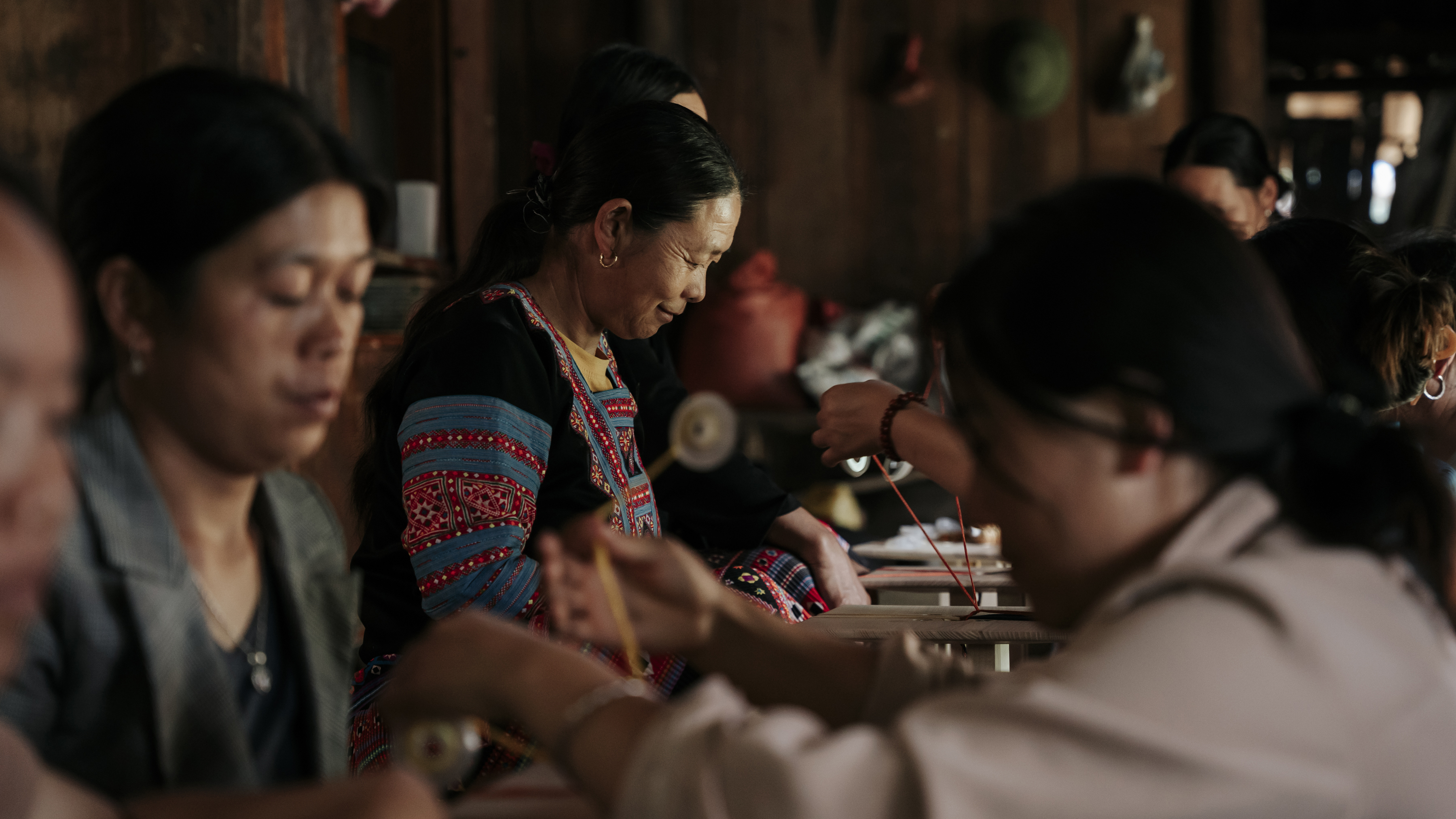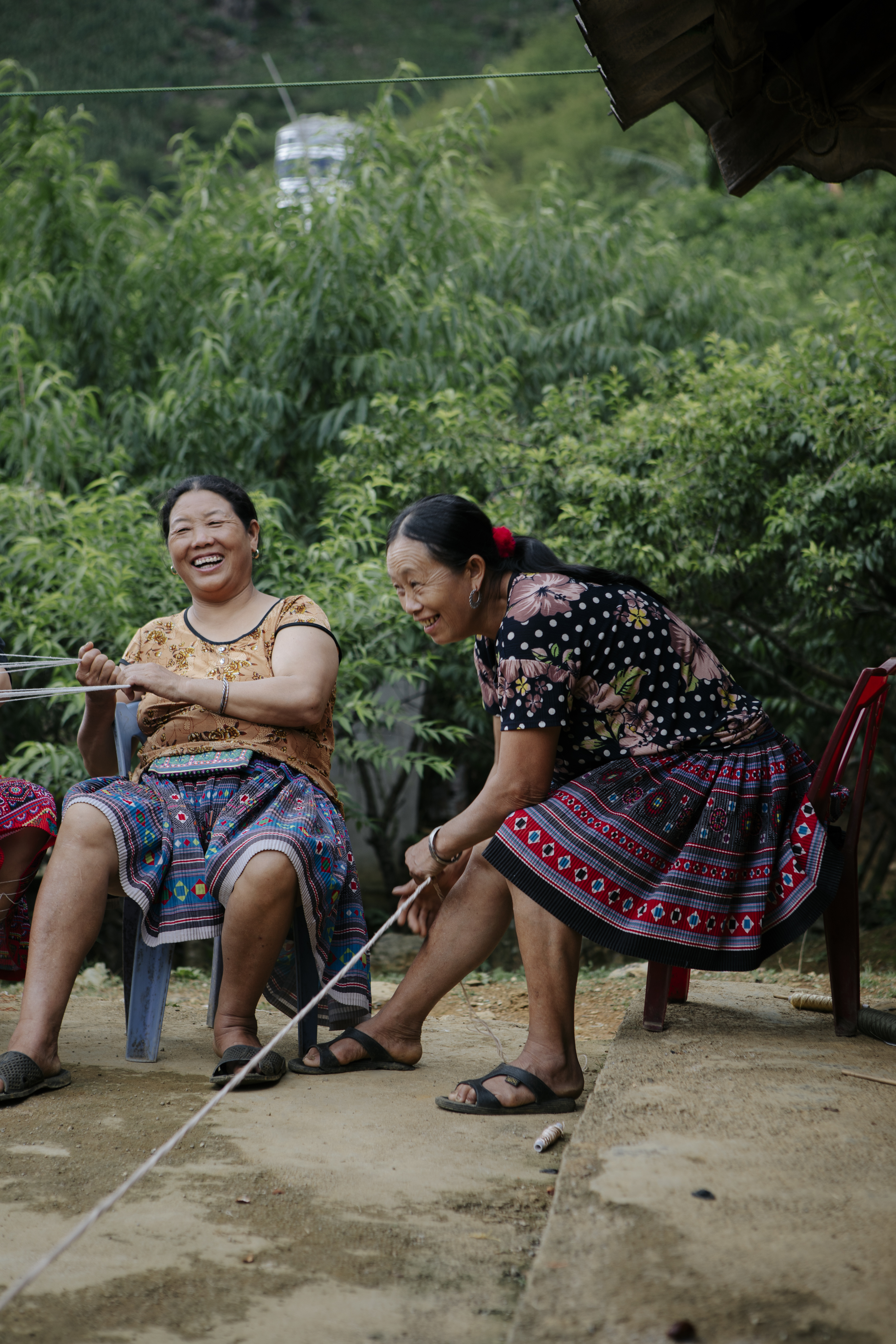
Land, Water, Heaven: Cross Encounters, Joining Threads
Exploring the power of feminine deities through craft and community.
The film follows three groups of female creatives, the Blue H’mong craftswomen of Pà Có village, the candle artisans of WAX Atelier and designer Thao Vu from Kilomet109 as they collaborate to create a braided rope as an offering to the Mother Goddess; honouring the skies and water, the universal values of creation and ancient protection of the natural realm. This is a journey to meet a fantasy made reality.
The visual narrative uses craft gestures to explore the physicality and theatre of turning plants into products, intertwining cross-cultural ideas and crafts skills between the UK and Vietnam. Through the lens of the Mother Goddess -The Earth, we rediscover how these ancient beliefs and rituals continue to shape our lives today. From the sacred power of plants to the beauty of community, this film celebrates the divine and the creative spirit.
The film captures the beauty, and the physicality of creating this rope; it being a symbol of female collaboration and the joining of hands across cultures. It is a celebration of the divine feminine and the power of women to co-create and to connect.
︎︎︎ Full screen recommended for online streaming
About the film
Context
This poetic short-film has been created within a wider project: Mother Goddess of the Three Realms: Cross Encounters, Joining Threads, developed by Wax Atelier and Kilomet 109. The project, funded by British Council within the UK/Viet Nam Season 2023, had at its core the intention to bridge cultures through craft and arts. Following the practices of both creative studios, that celebrate tradition with a modern view, they wanted to challenge traditional ideas around craft making, in this occasion, by exploring the act of making through the perspective of performance and theatre.
I was invited to join as visual and movement artist to be part of their three week residency in Viet Nam, working with the Hmong artisans in Pà Có and delivering a series of workshops at APD Art Centre in Ha Noi. My contribution was to document and film the experience in Pà Có and create a film, and in Ha Noi to direct activities exploring the physicality of making as a performative act.
Conversations previous to the residency developed around ideas about how to translate their proposal: working with threads, rope and kumihimo braiding -a japanese technique-, into an act that involved the whole body and was communal and performative. The proposal was to upscale the braiding set up and to read the kumihimo instructions as choreographic scores. These ideas, together with new inputs during the process, guided us during the time at Pà Có village, the filming of the process and the planning and creation of the final scene, a sort of group ritual in celebration of our experience.






Process
We arrived to Pà Có, in the province of Mai Chau, where the H´mong artisan women live and work at the start of June. Wax Atelier, Vu Thao and myself spent nine days working with ten women from the community.
During this time Wax Atelier shared the kumihimo braiding and started the process of making the rope for the upscale version. The artisans worked with fabric and hemp to build the rope from scratch. Hemp is a local fibre with multiple usages, women harvest the plant, separate the fibre, and spin it in order to make it into fabric, among other processes and usages. Other materials that they produce are paper and wax, used in techniques such as batik. They also work with natural dyes such as indigo and yam root, and create traditional garments with very elaborate sewing styles.
For most of the filming the approach was to have an observational point of view, to capture the moments in between, the small intimate situations. The intention was to be part of the space minimising the intimidating impact that the camera can have among groups.
In my work I believe that it is key to develop relationships with those being filmed or photographed, in order to gain their trust and openness but also to understand their experience and therefore capture it with empathy. During the filming, we learned and practised kumihimo, played with the kids, shared quotidian moments like feeding the animals, and danced and sang creating the last scene. Behind the camera I also had the chance to observe the vitality that the community has, the love for their children, their habit of cooperation and collaboration; I heard conversations about love and cultural traditions, about climate change and the impact in their crops. Much of the opennes of this group of artisans came from the long term relationship and work with Thao Vu, director of Kilomet 109, who through her brand is reviving traditional making processes.
The result was a large amount of hours of footage, meaning a process of editing that lasted several weeks.
The first stage was the visualisation and classification of all the material, as well as a first selection of key moments. Then the editing started. From the start the art direction that Wax Atelier had proposed was to leave space for abstraction, for poetry. The film was not intended to be a precise description of our time there, but to convey a sensorial feeling of our experiences. The process of achieving this abstraction was slow, it was necessary to first see the documentary layer of the story to then peel it off and reach the core of the film.
An important element to convey this ‘otherness’ and simultaneously give coherence to the continuity of the film was the soundtrack. Yesenia Thibault-Picazo created a poetic composition using field recordings of nature and some of the artisans singing, as well as her own playing. Once the first draft was created, we worked for around three weeks in fine tuning the sounds and details to synchronise with the images and the editing. Both the sound and the film fed each other to inspire the final composition.



Style
The film blends documentary and fictional elements. In the ethos of the project there was the intention of experimenting through cultural exchange. This experimentation happened through finding a different physicality in the act of making, as well as in the form of the film. The proposal was to search for a certain abstraction and poetry, to allow space for mystery, space for interpretation, a message that is not completely defined and closed.
The images convey a sense of community, femininity, connection to nature, a sense of vitality, of co-working for a greater good. These values and ideas have a universality that connects with different audiences anywhere in the world.



Credits
Filmmaker
Rocio Chacon is an image maker and movement artist based in London, working primarily with photography and video within performance, arts and design. In her personal work, she is inspired by the natural world and the human condition, searching to suggest another perception of reality. Her background in documentary and media informs her ability to articulate a shared vision in collaborations and commissioned work. Through her usage of colour and light Rocio builds narrations full of poetry and empathy.
In this collaboration with Wax Atelier she joined them in Viet Nam, working with the H´mong women artisans and facilitating a series of movement workshops around materiality and craft to a young artist community at APD Centre, Hà Noi.
Sound Designer
Yesenia Thibault-Picazo (1987, France) is a interdisciplinary designer and sound artist exploring the narrative potential of materials. She defines herself as a ‘material teller', and uses design as a tool to engage diverse audiences in contemporary ecological challenges. She is interested in exploring a practice that bridges between research and design industry through long term projects and collaborations with experts in the field of art, crafts, natural and social sciences.

A project by Wax Atelier and Kilomet 109
Led by Lola Lely Studio and Thao Vu
Film Director: Rocio Chacon
Art Direction: Yesenia Thibault-Picazo
Movement Direction: Rocio Chacon
Producer: Wax Atelier
With the participation of the Blue H’mong Women Artisans in Pà Cò:
Mùa Y Đía, Sùng Y Khô, Sùng Y Vang, Sùng Y Thanh, Sùng Y Sống, Giàng Y Hoa, Sùng Y Nông, Sùng Y Lan, Sùng Y Dua, Giàng Y Día, Sùng Thị Mìa, Tếnh Y Va.
Singing: Giàng Y Día & Tếnh Y Vang , Sùng Y Vang
Construction of the structure: Sùng A Dương
Camera: Rocio Chacon
Assistant: Phàng A Trưởng
Sound Design: Yesenia Thibault-Picazo
Editing: Rocio Chacon
Special thanks to A Páo Homestay and family, Phàng A Páo & SÙng Y Gánh, Bàn Thị Nguyệt and APD Centre, Ha Noi
Funded by British Council , UK/Vietnam Season 2023
Supported by Centre 151 and Camira Fabrics
Part of the program:
London Design Festival @l_d_f_official
Vietnam Design Week @vietnamdesignweek
Shoreditch Design Triangle @shoreditchdt
ESEA Heritage Month @besea.n
